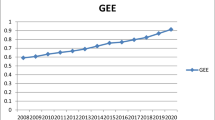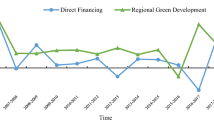Abstract
Since the 1994 China’s tax-sharing reform, land finance has far-reaching influence on fiscal system and has critical implications for green development and industrial structure optimization. Previous studies have largely focused on the environmental aspect of land finance by considering carbon emissions as environmental indicator only and ignored social and economic aspects. To fill the research gaps, this study analyzed spatial and moderating effects of land finance on green development through rationalized industrial structure, quantity of advanced industrial structure, and quality of advanced industrial structure in 246 Chinese cities from 2006 to 2019. The results document that local and surrounding land finance have negative effect on China’s green development. Local land finance inhibits green development in western and large cities, while surrounding land finance deteriorates in eastern and large cities. Through mediation of industrial structure optimization, land finance accelerates green development in national, eastern, and large cities. In western cities, land finance promotes green development through quantity and quality of industrial structure upgrading. In small- and medium-sized cities, quantity of industrial structure upgrading plays a positive role.



Similar content being viewed by others
Data Availability
The data and materials are available upon request.
Notes
To conserve space, we did not present the mathematical equations of the super-SBM model.
References
Chen J, Wang L, Li Y (2020) Research on the impact of multi-dimensional urbanization on China’s carbon emissions under the background of COP21. J Environ Manag 273:111123
Démurger S (2001) Infrastructure development and economic growth: an explanation for regional disparities in China? J Comp Econ 29(1):117
Deng HH, Yang LX, Pan XT (2020) High-speed rail and industrial upgrading in China: facts and mechanisms. J Financ Econ 46(06):34–48
Du W, Li M (2021) The impact of land resource mismatch and land marketization on pollution emissions of industrial enterprises in China. J Environ Manag 299:113565
Fu L-H (2010) An empirical research on industry structure and economic growth. Stat Res 27(08):79–81
Guo W, Zhou Y (2020) Does land finance promote high quality economic development? A mediating effect perspective based on urbanization and industrial structure upgrading. South China Finance (10):28–39
He C, Huang Z, Wang R (2014) Land use change and economic growth in urban China: a structural equation analysis. Urban Stud 51(13):2880–2898
He C, Zhou Y, Huang Z (2016) Fiscal decentralization, political centralization, and land urbanization in China. Urban Geogr 37(3):436–457
He Q, Du J (2022) The impact of urban land misallocation on inclusive green growth efficiency: evidence from China. Environ Sci Pollut Res 29(3):3575–3586
Hou S, Song L, Wang J, Ali S (2021) How land finance affects green economic growth in Chinese cities. Land 10(8):819
Kok N, Monkkonen P, Quigley JM (2014) Land use regulations and the value of land and housing: An intra-metropolitan analysis. J Urban Econ 81:136–148
Kunce M, Shogren JF (2007) Destructive interjurisdictional competition: firm, cap- ital and labor mobility in a model of direct emission control. Ecol Econ 60(3):543–549
Lefebvre H (1991) The production of space. Blackwell Publishing, Oxford
Li G, Gao D, Li Y (2023) Impacts of market-based environmental regulation on green total factor energy efficiency in China[J]. China World Econ 31(3):92–114. https://doi.org/10.1111/cwe.12485
Liu X, Xu HZ, Zhang M (2022) Impact and transmission mechanism of land leasing marketization on carbon emissions: based on the mediating effect of industrial structure. China Popul Resour Environ 32(6):12–21
Lu X, Zhang Y, Li J, Duan K (2022) Measuring the urban land use efficiency of three urban agglomerations in China under carbon emissions. Environ Sci Pollut Res 29(24):36443–36474
Lu XX, Teng YS (2020) How the heterogeneity of land financial dependence affects regional economic development? Study Exp 120–129. https://doi.org/10.3969/j.issn.1002-462X.2020.07.014
Misczynski DJ (1986) The fiscalization of land use. California Pol Choices 3:127–150
Mo J (2018) Land financing and economic growth: evidence from Chinese counties. China Econ Rev 50:218–239
Peterson GE (2013) Unlocking land values to finance urban infrastructure. Social Science Electronic Publishing
Rasli AM, Qureshi MI, Isah-Chikaji A et al (2018) New toxics, race to the bottom and revised environmental Kuznets curve: the case of local and global pollutants. Renew Sust Energ Rev 81:3120–3130
Sha R, Li J, Ge T (2021) How do price distortions of fossil energy sources affect China’s green economic efficiency?. Energy 232:121017
Shan Y, Guan D, Liu J et al (2017) Methodology and applications of city level CO2 emission accounts in China. J Clean Prod 161:1215–1225
Shu C, Xie H, Jiang J, Chen Q (2018) Is urban land development driven by economic development or fiscal revenue stimuli in China? Land Use Policy 77:107–115
Song M, Ma X, Shang Y, Zhao X (2020) Influences of land resource assets on economic growth and fluctuation in China. Res Policy 68:101779
Sun J, Zhou T (2023) Urban shrinkage and eco-efficiency: the mediating effects of industry, innovation and land-use. Environ Impact Assess Rev 98:106921
Sun Q, Feng Y, Tang Y et al (2022) The relationship amid land finance and economic growth with the mediating role of housing prices in China[J]. Front Psych 13:976236
Tang P, Shi X, Gao J, Feng S, Qu F (2019) Demystifying the key for intoxicating land finance in China: an empirical study through the lens of government expenditure. Land Use Policy 85:302–309
Tao R, Su F, Liu M, Cao G (2010) Land leasing and local public finance in China’s regional development: evidence from prefecture-level cities. Urban Stud 47(10):2217–2236
Tian L (2015) Land use dynamics driven by rural industrialization and land finance in the peri-urban areas of China: the examples of Jiangyin and Shunde. Land Use Policy 45:117–127
Wang D, Ren C, Zhou T (2021a) Understanding the impact of land finance on industrial structure change in China: insights from a spatial econometric analysis. Land Use Policy 103:105323
Wang D, Ren C, Zhou T (2021b) Understanding the impact of land finance on industrial structure change in China: insights from a spatial econometric analysis. Land Use Policy 103:105323
Wang G, Salman M (2023) The driving influence of multidimensional urbanization on green total factor productivity in China: evidence from spatiotemporal analysis. Environ Sci Pollut Res 30(18):52026–52048
Wang LO, Wu H, Hao Y (2020a) How does China’s land finance affect its carbon emissions?. Struct Chang Econ Dyn 54:267–281
Wang LO, Wu H, Hao Y (2020b) How does China’s land finance affect its carbon emissions? Struct Change Econ Dyn 54:267–281
Wang Q, Zeng YE, Wu BW (2016) Exploring the relationship between urbaniza- tion, energy consumption, and CO 2 emissions in different provinces of China. Renew Sust Energ Rev 54:1563–1579
Xia F, Li Y, Yan J (2014) The relationship between land finance and economic growth under the industrial structure perspective—based on dynamic panel data analysis with Sys-GMM methods. Econ Geogr 34(12):85–92
Yang J, Li G (2014) Fiscal and spatial characteristics of metropolitan government and planning in China: understanding centralization trends in a decentralization context. Habitat Int 41:77–84
Yang X, Wang W, Su X et al (2023) Analysis of the influence of land finance on haze pollution: an empirical study based on 269 prefecture‐level cities in China[J]. Growth Chang 54(1):101–134
Yue SM, Lu Y (2016) Transmission mechanism of land finance affects economic growth in China-numerical model derivation and analysis based on interprovincial panel data. Finance Trade Econ 37:47–105
Zeng L, Wang Y, Deng Y (2022) How land transactions affect carbon emissions: evidence from China. Land 11(5):751
Zhang J, Wu G-Y, Zhang J-P (2004) The estimation of China’ s provincial capital stock:1952 —2000. Econ Res J 10:35–44
Zhang W, Xu H (2017) Effects of land urbanization and land finance on carbon emissions: a panel data analysis for Chinese provinces. Land Use Policy 63:493–500
Zhang Z (2017) The mutual effects between the fiscal relations of central and local governments and economic growth in post-reform China. Evol Inst Econ Rev 14(1):101–116
Zhong S, Li X, Ma J (2022) Impacts of land finance on green land use efficiency in the Yangtze River Economic Belt: a spatial econometrics analysis[J]. Environ Sci Pollut Res 29(37):56004–56022
Zhong T, Zhang X, Huang X, Liu F (2019) Blessing or curse? Impact of land finance on rural public infrastructure development. Land Use Policy 85:130–141
Zhou B, Zhou C (2018) Land finance, industrial structure and economic growth-a study based on data of 284 cities above prefecture level. Economist 5:39–49
Author information
Authors and Affiliations
Contributions
Guimei Wang: conceptualization, methodology, software, data curation, writing—original draft preparation, visualization, and investigation. Muhammad Salman: writing—reviewing and editing.
Corresponding author
Ethics declarations
Ethical approval
We testify that this study is our original research with all data acquired by our examination and there is no plagiarism in it. We also affirm that this study has not been published elsewhere and is not under consideration by another journal.
Consent to publication
This is not applicable.
Consent to participate
This is not applicable.
Competing interests
The authors declare no competing interests.
Additional information
Responsible Editor: Nicholas Apergis
Publisher’s note
Springer Nature remains neutral with regard to jurisdictional claims in published maps and institutional affiliations.
Rights and permissions
Springer Nature or its licensor (e.g. a society or other partner) holds exclusive rights to this article under a publishing agreement with the author(s) or other rightsholder(s); author self-archiving of the accepted manuscript version of this article is solely governed by the terms of such publishing agreement and applicable law.
About this article
Cite this article
Wang, G., Salman, M. Understanding the spatial spillover effect of land finance on China’s green development: does the moderating role of industrial structure matter?. Environ Sci Pollut Res 30, 95959–95974 (2023). https://doi.org/10.1007/s11356-023-29194-1
Received:
Accepted:
Published:
Issue Date:
DOI: https://doi.org/10.1007/s11356-023-29194-1




